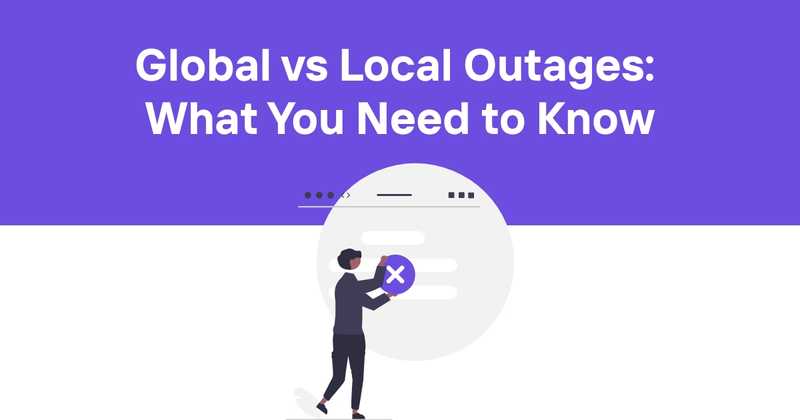Global vs. Local Outages: What You Need to Know
Global versus Local: Internet Outages - All You Need to Know
In today's world of hyperconnectivity, everything from business operations to personal communication would be in jeopardy in case of an internet outage. Understanding the difference between global and local outages is key to preparing for disruptions and minimizing their impact.
What is a Global Outage?
Global outages are severe events affecting vast areas, many times crossing international boundaries. These have the potential to cause disruptions to crucial services, including cloud computing, social media platforms, and major websites. They generally originate from a problem in global network providers such as Content Delivery Networks-otherwise known as CDNs-or core internet infrastructure. Common causes include:
- Configuration errors that propagate through the network
- Software bugs introduced by new updates
- Massive infrastructure failures, such as damaged undersea cables
A global outage brings online activity to a grinding halt, affecting not only e-mail communications but financial transactions as well. Such is disastrous for business. Sustained financial losses, reduced productivity, and reputational damage may follow with global outages.
What is a Local Outage?
In contrast, the local ones reach out to a much smaller-scale area, such as neighbourhoods, cities, or even particular buildings. While they may not capture many headlines, the local outages are still very serious problems, in particular to businesses operating inside the zone of the outage. These disruptions often result due to:
- Local hardware failures, such as routers or switches going offline
- Damaged cables, whether due to construction or natural causes
- Local network configuration errors
The first one does not impact the global traffic but introduces latency to throttle the performance of the end users. Any rerouting of traffic would eventually increase the response time to the other servers or PoPs and may result in cold cache impact that further slows down service within an area.
Causes of Global and Local Outages
Understanding the causes can help in their prevention:
- Infrastructure Failures
- Global: Failures related to the key components-CDNs that make the global backbone of the Internet.
- Local: Low level infrastructure issues, e.g. malfunctioning routers, cut cables.
- Software and Configuration Errors
- Global: Issues regarding bugs or wrong settings that disturb global internet traffic.
- Local: Those executed through a local update or configuration on servers.
- Overload and Capacity Issues
- Global: Spiking demand, e.g. some viral occurrence or very high traffic, live stream across the globe.
- Local: The network itself is swamped by local floods of traffic.
- Human factor
Failure can be both global and/or local due to incorrect setting by a user and/or accidental override.
- Power Failures
More than anything, power failures-at least on a localized level-can effectively bring down the entire network, data centers included.
Impact on Business and Consumer
Businesses
Both of these types can be seriously disruptive to business.
- Financial Loss: "Money is lost when services are down, especially those using e-commerce or digital platforms.".
- Operational Disruptions: Applications on the Internet-from usage of cloud services to communications management-come to an end.
- Reputation Damage: Continuous breakdowns damage customer trust and loyalty.
Consumers
The consumers also suffer due to connectivity:
- Denial of Access: Normal services like online banking or entertainment are no longer accessible.
Barriers to Communications: Such a step will leave workers and their families bereft of the essential means of communications through emails or messaging.
Monitor and respond to local outages
To those businesses that must remain online, knowing when a local outage is occurring becomes really important. With Odown, through real-time visibility into outages, services are offered from 17 Data Centers across the Americas, EMEA, and the Asia Pacific region. This network thus allows quicker detections of regional outages and timely notifications by companies. Knowing whether it is a global or a local outage will help businesses decide if the problem is their own issue or part of a bigger one, and that helps in faster response times and reduction of downtown.
Outage Recovery and Lessons Learned Whatever that may be, be global or local, there should be a structured recovery plan. To have minimum impact inside the businesses, here it is:
- Immediacy: Notification to stakeholders, transparency of communication in case of an outage.
- Contingency Planning: Mitigation plans must be in place for these impacts, which might include an alternate connection or cached data.
- Post-Outage Review: Identify what went wrong and how similar situations can be avoided in the future.
- Building Resilience: Invest in robust technology, diversify service providers, and educate teams on protocols in case of an outage.
Conclusion
However, both global and local outages have causes and far-reaching consequences to businesses and their end-consumers. This is while global outages make internet access break down completely in some areas, whereas in other areas, performance might be affected. Business-wise, one can try to catch an outage through monitoring tools like Odown so prompt action could be taken to resume normal operations as early as possible. Being prepared for awareness will minimize the impact of these service disruptions and make you resilient in the connectivity-dependent world.



